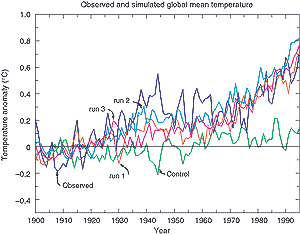
Figure 13: Observed and modelled global annual mean temperature anomalies (°C) relative to the average of the observations over the period 1900 to 1930. The control and three independent simulations with the same greenhouse gas plus aerosol forcing and slightly different initial conditions are shown from an AOGCM. The three greenhouse gas plus aerosol simulations are labelled ‘run 1’, ‘run 2’, and ‘run 3’ respectively. [Based on Figure 8.15]